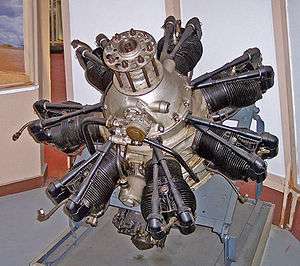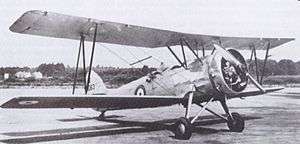Armstrong Siddeley Cheetah
| Cheetah | |
|---|---|
 | |
| Cheetah X | |
| Type | Radial engine |
| National origin | United Kingdom |
| Manufacturer | Armstrong Siddeley Motors Ltd. |
| First run | 1935 |
| Major applications | Airspeed Oxford |
| Number built | >37,200 |
| Developed from | Armstrong Siddeley Lynx |
The Armstrong Siddeley Cheetah is a seven-cylinder British air-cooled aircraft radial engine of 834 cu in (13.65 L) capacity introduced in 1935 and produced until 1948. Early variants of the Cheetah were initially known as the Lynx Major.[1]
The Cheetah was used to power many British trainer aircraft during World War II including the Avro Anson and Airspeed Oxford.
Design and development
The Cheetah was developed from the earlier Lynx using the increased bore cylinders from the Armstrong Siddeley Panther but the engine retained the stroke of the Lynx. Initially only direct-drive variants were produced with later engines being made available with propeller reduction gear of various ratios. Superchargers were also available for later variants, both geared and directly driven by the crankshaft.[1]
The basic design of the Cheetah remained unchanged from its introduction in 1935 to the last examples built in 1948. It was the first engine of its type to be certified for 1,200 hours of operational time between overhauls (TBO), with over 37,200 examples built.[2]
Variants
- Lynx V (Lynx Major)
- 1930, 230 hp (171 kW).
- Cheetah V
- 1935, 270 hp (201 kW) at 2,100 rpm.
- Cheetah VA
- 1935, 285 hp (212 kW) at 2,425 rpm.
- Cheetah VI
- 1935, 307 hp (229 kW) at 2,425 rpm.
- Cheetah VIA
- 1936, as Mk VI but with Mk IX cylinders.
- Cheetah IX
- 1937, 345 hp (257 kW) at 2,425 rpm.
- Cheetah X
- 1938, 375 hp (280 kW) at 2,300 rpm.
- Cheetah XI
- 345 hp (257 kW) at 2,425 rpm, geared version of Cheetah X.
- Cheetah XII
- Similar to Mk X, adapted for target drone aircraft.
- Cheetah XV
- 420 hp (313 kW) at 2,425 rpm.
- Cheetah XVII
- 1948, 385 hp (287 kW) at 2,425 rpm.
- Cheetah XVIII
- 385 hp (287 kW) at 2,425 rpm, carburettor modified for aerobatics.
- Cheetah XIX
- 355 hp (265 kW) at 2,425 rpm
- Cheetah 25
- 345 hp (257 kW) at 2,425 rpm, Cheetah XV uprated to 475 hp (355 kW) at 2,700 rpm, modified constant-speed unit.
- Cheetah 26
- 385 hp (287 kW).
- Cheetah 27
- 1948, 385 hp (287 kW).
Applications

- Airspeed Consul
- Airspeed Courier
- Airspeed Envoy
- Airspeed Oxford
- Airspeed Queen Wasp
- Airspeed Viceroy
- Avro 626
- Avro 652
- Avro Anson
- Blackburn Lincock
- Bristol Bulldog
- CASA C-201 Alcotán
- de Havilland Hawk Moth
- Edgar Percival Prospector
- Handley Page H.P.R.2
- Hispano HS-42
- IAe.22 DL
- Kingsford Smith PL.7
- Koolhoven F.K.51
- Marinens Flyvebaatfabrikk M.F.8
- Marinens Flyvebaatfabrikk M.F.10
- Percival Provost (prototype)
- SEA-1
- VEF JDA-10M
Survivors
As of October 2008 at least four Cheetah engines remained airworthy. Two Cheetah 17s power the Anson T21 operated by the Classic Air Force and another pair of Cheetah 17s are fitted to Avro Nineteen, G-AHKX registered to BAE Systems but normally based at the Shuttleworth Collection.[5][6]
Engines on display
Preserved Armstrong Siddeley Cheetah engines are on public display at the following museums:
- Arkansas Air and Military Museum
- Aviation Heritage Museum (Western Australia)[7]
- Brooklands Museum
- Fleet Air Arm Museum
- Malta Aviation Museum
- Port Elizabeth branch of the South African Air Force Museum
- Royal Air Force Museum Cosford
Specifications (Cheetah IX)
01.jpg)
Data from [8]
General characteristics
- Type: Seven-cylinder single-row supercharged air-cooled radial engine
- Bore: 5.25 in (133 mm)
- Stroke: 5.5 in (140 mm)
- Displacement: 834 cu in (13.65 L)
- Length: 52.8 in (1,342 mm)
- Diameter: 47.6 in (1,210 mm)
- Dry weight: 637 lb (289 kg)
Components
- Valvetrain: Two pushrod-actuated valves per cylinder
- Supercharger: Centrifugal, 5.4:1 reduction
- Fuel system: Claudel-Hobson carburettor
- Fuel type: 87 octane rating petrol
- Cooling system: Air-cooled
- Reduction gear: No
Performance
- Power output:
- 338 hp (252 kW) at 2,100 rpm for takeoff
- 345 hp (257 kW) at 2,425 rpm at 7,875 ft (2,400 m)
- Specific power: 0.41 hp/cu in (18.83 kW/L)
- Compression ratio: 6.35:1
- Specific fuel consumption: 0.45 lb/hp/hr (271 g/kW/hr)
- Oil consumption: 0.24–0.45 oz/hp/hr (9–17 g/kW/hr)
- Power-to-weight ratio: 0.54 hp/lb (0.89 kW/kg)
See also
- Related development
- Comparable engines
- Related lists
References
Notes
- 1 2 Lumsden 2003, p.74.
- ↑ Gunston 1989, p.18.
- ↑ Lumsden 2003, pp.74-76.
- ↑ Cheetah variants start at Mk V.
- ↑ CAA - G-INFO - G-VROE Retrieved: 15 February 2009
- ↑ CAA - G-INFO - G-AHKX Retrieved: 15 February 2009
- ↑ http://www.raafawa.org.au/museum/engines
- ↑ Lumsden 2003, p.75.
Bibliography
- Gunston, Bill. World Encyclopedia of Aero Engines. Cambridge, England. Patrick Stephens Limited, 1989. ISBN 1-85260-163-9
- Lumsden, Alec. British Piston Engines and their Aircraft. Marlborough, Wiltshire: Airlife Publishing, 2003. ISBN 1-85310-294-6.
Further reading
- Bridgman, L, ed. (1998). Jane's fighting aircraft of World War II. Crescent. ISBN 978-0-517-67964-7.
- Gunston, Bill. Development of Piston Aero Engines. Cambridge, England. Patrick Stephens Limited, 2006. ISBN 0-7509-4478-1
External links
| Wikimedia Commons has media related to Armstrong Siddeley Cheetah. |